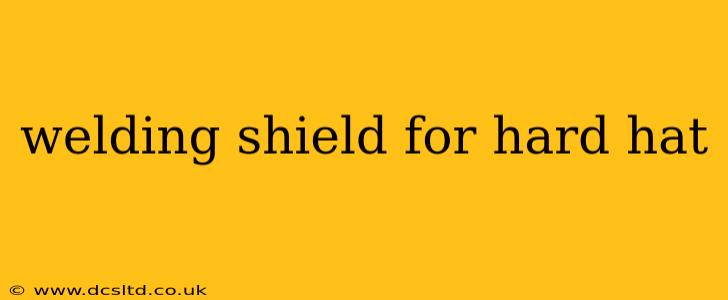Welding is a crucial process in numerous industries, but it comes with inherent risks. Protecting your eyes and face from intense light, heat, and spatter is paramount. This is where a welding shield for a hard hat becomes essential. This comprehensive guide will explore everything you need to know about choosing the right welding shield, ensuring your safety on the job.
What is a Welding Shield for a Hard Hat?
A welding shield, also known as a welding helmet attachment or hard hat face shield, is a crucial piece of personal protective equipment (PPE). It attaches securely to your hard hat, providing a clear barrier between your face and the welding arc. This shield protects against harmful ultraviolet (UV) and infrared (IR) radiation, intense light, and flying sparks and spatter generated during the welding process. Choosing the right one is crucial for both comfort and safety.
Types of Welding Shields for Hard Hats
Several types of welding shields cater to various needs and welding processes. Understanding these differences is key to selecting the appropriate one for your work:
1. Flip-Front Welding Shields:
These shields feature a flip-front design, allowing you to easily raise and lower the protective lens. This convenience is ideal for tasks requiring frequent interruptions or changes between welding and other activities.
2. Fixed Welding Shields:
Offering a more streamlined profile, fixed shields provide continuous protection but may require removing the entire shield for non-welding tasks.
3. Shades and Lens Options:
The shade number of the welding lens is critical. This number indicates the level of protection from the welding arc's intensity. Different welding processes require different shade numbers. You'll typically find lenses ranging from shade 5 to shade 14. Choosing the right shade is non-negotiable for eye safety.
How to Choose the Right Welding Shield
Several factors influence the selection of a welding shield for your hard hat:
1. Compatibility with your Hard Hat:
Ensure the shield is compatible with the type and brand of your hard hat. Look for specific compatibility information from the manufacturer. Many shields offer adjustable mounting systems to accommodate various hard hats.
2. Shade Number Selection:
The shade number is determined by the welding process. Consult relevant safety guidelines and standards to determine the appropriate shade for your specific application. Using the wrong shade can lead to serious eye damage.
3. Field of Vision:
A wider field of vision enhances situational awareness and improves work efficiency. Consider shields with large viewing areas for better visibility.
4. Durability and Weight:
Opt for a durable shield constructed from impact-resistant materials that can withstand the rigors of the welding environment. However, balance durability with weight; a heavy shield can become uncomfortable during prolonged use.
5. Comfort and Adjustability:
A comfortable shield with adjustable features (such as head straps or tilt adjustments) is crucial for prolonged use. Discomfort can lead to improper use and reduced safety.
What are the different lens materials used in welding shields?
Welding shields utilize various lens materials, each offering different properties. Common materials include:
- Glass: Offers good clarity and is relatively inexpensive, but it's more prone to shattering than other options.
- Polycarbonate: A lightweight, impact-resistant option that offers superior protection against shattering. It also offers better UV protection than glass.
How do I clean and maintain my welding shield?
Regular cleaning and maintenance are essential to ensure optimal clarity and prolong the life of your welding shield. Use a soft cloth and a suitable cleaning solution to remove debris and spatter. Avoid harsh chemicals or abrasive materials that could scratch the lens.
How often should I replace my welding shield?
Replace your welding shield if it shows any signs of damage, such as cracks, scratches, or significant discoloration. Even minor damage can compromise its protective capabilities and endanger your eyes. Regular inspection is crucial.
Choosing the right welding shield is an investment in your safety. By considering the factors outlined above, you can select a shield that provides reliable protection and enhances your comfort and efficiency on the job. Remember, your eyesight is invaluable; never compromise on safety.
